
Welcome, as always, to ‘Final Frontier Friday’! We’re back with more of our ongoing look at the franchise’s pilot episodes as we count down to the September premiere of ‘Star Trek: Discovery’. This week, we’re taking our first steps beyond the original series as we examine the premiere episode of ‘Star Trek: The Animated Series’ (or ‘The Animated Adventures of Gene Roddenberry’s Star Trek’, if you’re not into the whole brevity thing).
In 1969, ‘Star Trek’ was cancelled after three seasons of ratings struggles and network mismanagement. Despite this and despite the series’ seventy-nine episode run falling well short of the “magic number”, the show was nonetheless sold into syndication. It was here, in reruns in the early 1970s, that it really started to build its audience. It wasn’t long before the powers that be began to take notice, and a revival soon followed, bringing ‘Star Trek’ back to screens the world over.
To a more casual fan, the story I just told was of ‘Star Trek’ making the jump from television to the cinema. And in the broad strokes, that’s absolutely the case. But it wasn’t exactly a straight line from the small screen to the silver. Paramount (who had purchased Desilu in 1967) knew they wanted more ‘Star Trek’, but for most of the seventies they just didn’t quite know how to go about getting it. Indeed, while there’s a gap of about a decade between the cancellation of ‘Star Trek’ and the premiere of ‘Star Trek: The Motion Picture’, that was largely due to the project getting trapped in development hell, as the studio heads constantly flipped back and forth between any number of options, from feature films to movies of the week to a full blown television revival (which very nearly materialized as ‘Star Trek: Phase II’) before finally settling on a theatrical feature after the success of ‘Star Wars’.
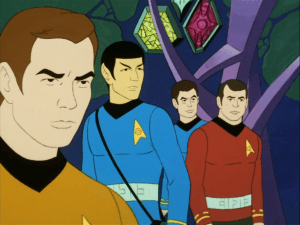
But before all of the televised revivals that almost were, ‘Star Trek’ had already returned to the airwaves, this time as a Saturday morning cartoon. Produced by Filmation and airing between September 1973 and October 1974, the series is something of an oddity as ‘Trek’ shows go. While it is unmistakably a Filmation production of the period (with all the rotoscoping and gratuitous use of stock footage that implies), it’s also unmistakably ‘Star Trek’. Not only did nearly the entire cast return to voice their characters (the sole exception -Walter Koenig – remained involved as a writer), Roddenberry also made sure to bring a number of established ‘Trek’ writers aboard while continuing the original series’ tradition of recruiting prominent sci-fi writers to provide scripts. Just as important, this was a series that refused to write down to its audience. If anything, it took full advantage of a format that others at the time might understandably have found restrictive, as Roddenberry and the writers understood that animation would allow them to explore ideas that they could never have afforded to realize on a live action budget.
Appropriately enough, the series opened with an example of just that. Written by Samuel A. Peeples (whose previous contributions included ‘Where No Man Has Gone Before’), the episode features environments of such an alien nature and scope that any live action show would have had trouble bringing them to life prior to the modern age of CGI, let alone a show facing the sort of budgetary restrictions that ‘Star Trek’ so often did. None of this was an accident. Naturally, the show wanted to flex its imaginative muscles, and according to Peeples himself, the decision to assign him the first animated episode was a deliberate echo of his involvement with the original series. But did ‘Beyond the Farthest Star’ echo the success of ‘Where No Man Has Gone Before? Well…
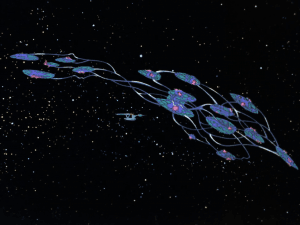 On a star charting mission at the edge of the galaxy, the Enterprise detects a radio signal. Attempting to trace the signal’s origin, the ship becomes trapped in the gravitational pull of a stellar remnant, barely managing to pull into a stable orbit. Once in orbit, they are able to trace the signal to a mysterious alien vessel. Seemingly abandoned, Spock estimates the ship has been trapped in orbit here for some three hundred million years. Along with Spock, McCoy, and Scotty, Kirk beams over to investigate the ship. Upon noticing the systematic nature of the damage to the ship, Spock suggests her crew may have attempted to destroy her.
On a star charting mission at the edge of the galaxy, the Enterprise detects a radio signal. Attempting to trace the signal’s origin, the ship becomes trapped in the gravitational pull of a stellar remnant, barely managing to pull into a stable orbit. Once in orbit, they are able to trace the signal to a mysterious alien vessel. Seemingly abandoned, Spock estimates the ship has been trapped in orbit here for some three hundred million years. Along with Spock, McCoy, and Scotty, Kirk beams over to investigate the ship. Upon noticing the systematic nature of the damage to the ship, Spock suggests her crew may have attempted to destroy her.
Kirk’s suspicions grow when Uhura informs him that the radio signal stopped transmitting once the landing party beamed aboard. They continue to explore, eventually reaching an area where the air and gravity approximate that of Earth. The party realizes they are trapped in this area on finding that Kirk’s attempt to contact the Enterprise are jammed. Suddenly, the ship seems to come to life, as some unknown force attempts to enter the room and a recording of a long-dead alien commander begins to play on the viewscreen. Spock is able to translate the message, which turns out to be a warning of the presence of a malevolent entity. The commander explains that they are protected only in this room and that they chose to destroy their own ship rather than risk letting this creature reach other inhabited worlds. Suddenly, the ship begins to explode. As the defenses around the room drop, Kirk and company are just barely beamed out in time.
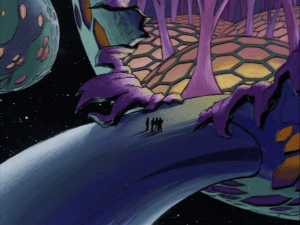 On returning to the Enterprise, they find that something resembling a green cloud has come aboard with them. Kirk tries to beam it back out, only to be stunned (along with everyone else in the transporter room) by the creature, which quickly disappears into the ship. Kirk orders Scotty to ready the self-destruct (just in case) while Spock watches for any changes from the ship’s normal functioning. The only noticeable difference is variable magnetic flux, which resembles a heartbeat. After a series of minor malfunctions affecting environmental systems and engineering control, the ship’s phasers suddenly activate, seemingly of their own volition, and destroy what’s left of the alien ship. From there, the malfunctions continue as the magnetic flux increases. Whatever the creature is, it’s taking control of the ship. Spock is able to erect a magnetic barrier around the helm controls, keeping the entity at bay. Kirk then deduces that the entity is trapped by the magnetic fields from the stellar remnant and that it needs a starship in order to break away. It then begins to speak to Kirk through the ship’s computer, demanding that he releases the helm’s defenses. Instead, Kirk damages the controls, though at the alien’s insistence, he orders Scotty to begin repairs. Spock supposes that the creature is a magnetic organism capable of symbiotic coexistence with a mechanical “body” – in this case, a starship. Under the guise of assisting Scotty with repairs, Spock begins mentally completing the calculations that will allow the ship to break out of orbit. With the necessary repairs complete, The engines are activated. The Enterprise begins falling into the dead star as the alien demands that Kirk increase power and pull away. Kirk refuses and as the collision grows imminent, the alien flees the Enterprise, becoming trapped within the dead star itself. Once they’re sure the ship is free, the Enterprise warps away, as the alien begs not to be left alone.
On returning to the Enterprise, they find that something resembling a green cloud has come aboard with them. Kirk tries to beam it back out, only to be stunned (along with everyone else in the transporter room) by the creature, which quickly disappears into the ship. Kirk orders Scotty to ready the self-destruct (just in case) while Spock watches for any changes from the ship’s normal functioning. The only noticeable difference is variable magnetic flux, which resembles a heartbeat. After a series of minor malfunctions affecting environmental systems and engineering control, the ship’s phasers suddenly activate, seemingly of their own volition, and destroy what’s left of the alien ship. From there, the malfunctions continue as the magnetic flux increases. Whatever the creature is, it’s taking control of the ship. Spock is able to erect a magnetic barrier around the helm controls, keeping the entity at bay. Kirk then deduces that the entity is trapped by the magnetic fields from the stellar remnant and that it needs a starship in order to break away. It then begins to speak to Kirk through the ship’s computer, demanding that he releases the helm’s defenses. Instead, Kirk damages the controls, though at the alien’s insistence, he orders Scotty to begin repairs. Spock supposes that the creature is a magnetic organism capable of symbiotic coexistence with a mechanical “body” – in this case, a starship. Under the guise of assisting Scotty with repairs, Spock begins mentally completing the calculations that will allow the ship to break out of orbit. With the necessary repairs complete, The engines are activated. The Enterprise begins falling into the dead star as the alien demands that Kirk increase power and pull away. Kirk refuses and as the collision grows imminent, the alien flees the Enterprise, becoming trapped within the dead star itself. Once they’re sure the ship is free, the Enterprise warps away, as the alien begs not to be left alone.
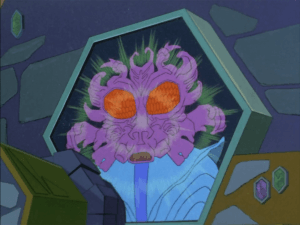 Taken on its own, ‘Beyond the Farthest Star’ is a solid episode, though not a mind-blowing one, and a good start for the animated series. In fact, it does the one thing a pilot absolutely has to do, which is to give the viewer a good idea of what to expect from the series. In particular, it showcases the possibilities that animation opens to ‘Star Trek’, particularly through the design of the alien ship and its commander. It also introduces the biggest difference between the animated ‘Star Trek’ and its live action counterparts, that being its half hour runtime. As you might expect, this means that the animated series has a much faster pace than other ‘Trek’ shows. While the episode doesn’t feel rushed exactly, the narrative isn’t given the sort of breathing room it would have in an hour long show.
Taken on its own, ‘Beyond the Farthest Star’ is a solid episode, though not a mind-blowing one, and a good start for the animated series. In fact, it does the one thing a pilot absolutely has to do, which is to give the viewer a good idea of what to expect from the series. In particular, it showcases the possibilities that animation opens to ‘Star Trek’, particularly through the design of the alien ship and its commander. It also introduces the biggest difference between the animated ‘Star Trek’ and its live action counterparts, that being its half hour runtime. As you might expect, this means that the animated series has a much faster pace than other ‘Trek’ shows. While the episode doesn’t feel rushed exactly, the narrative isn’t given the sort of breathing room it would have in an hour long show.
Now, I said that ‘Beyond the Farthest Star’ is a fine episode “taken on its own”. Which brings us to the biggest problem I have with the episode, namely that it feels somewhat derivative of Peeples’ own script for ‘Where No Man Has Gone Before‘. While there’s plenty to set the two episodes apart, the narratives, broadly speaking, are strikingly similar when you stop to think about it. To wit: Captain Kirk encounters a powerful, dangerous entity at the edge of the galaxy. In the course of the episode, he learns that a past starship captain encountered this thing and ultimately destroyed his own ship to prevent it from ever reaching civilization. Kirk is prepared to do the same, though he is ultimately able to defeat the creature, though only by the skin of his teeth. Now, which of the two episodes did I just describe? Exactly.
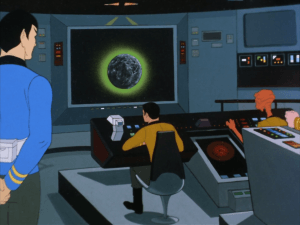 As for the cast, they all by and large acquit themselves well as voice actors. Voice acting calls for a different skill set than performing on stage or in front of a camera and not every actor can pull both off. But despite a few awkward line readings, they’re all there and the performances hit all of the right notes. This more than anything is key to making the animated series feel as much like ‘Star Trek’ as it does. If they had recast any of the leads, it would have gone a long way toward robbing the show of its legitimacy as a continuation of ‘Star Trek’.
As for the cast, they all by and large acquit themselves well as voice actors. Voice acting calls for a different skill set than performing on stage or in front of a camera and not every actor can pull both off. But despite a few awkward line readings, they’re all there and the performances hit all of the right notes. This more than anything is key to making the animated series feel as much like ‘Star Trek’ as it does. If they had recast any of the leads, it would have gone a long way toward robbing the show of its legitimacy as a continuation of ‘Star Trek’.
And finally, there is one thing that is impossible to ignore in any discussion of the animated series: the music. Such as it is. There can’t have been more than three or four pieces composed for the series, and only two of them ever end up in particularly heavy rotation. Those are the main theme, which is just an *incredibly* seventies rendition of the familiar ‘Star Trek’ theme, and what I can only describe as a sort of stock “action track” that will forever be burned into your brain if you binge watch the series. I’m not joking. They use it multiple times per episode. It is perhaps the purest example of Filmation’s determination to get their money’s worth out of the music, and whether you love it or hate it, you will never forget it.
Thanks once again for joining us. As always, I invite you to share your thoughts on ‘Beyond the Farthest Star’ in the comments. And of course, make sure you join us next week as we move on to ‘The Next Generation’ with our coverage of ‘Encounter at Farpoint’.
